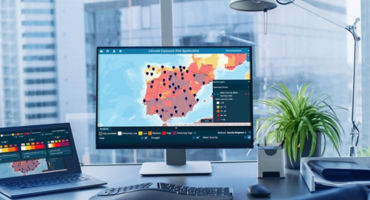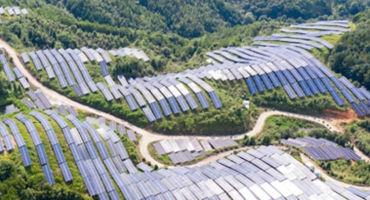- Director of Climate Research
Skip to main content
- Funds
- Insights
- Capabilities
- About Us
- My Account
The views expressed are those of the author at the time of writing. Other teams may hold different views and make different investment decisions. The value of your investment may become worth more or less than at the time of original investment. While any third-party data used is considered reliable, its accuracy is not guaranteed. For professional, institutional, or accredited investors only.
My experience working with large, sophisticated asset owners has led me to conclude that many are “short” climate change, with pockets of portfolios likely to underperform as climate risks intensify. A growing body of research,1 including our own work with Woodwell Climate Research Center, shows that the increasing frequency and severity of physical climate events may lead to negative economic outcomes and falling asset values. Why are the downside financial risks of climate change so prevalent across portfolios? In my view, there are two main reasons.
First, markets have long regarded climate change as a future problem that is too far away to matter, rather than a near-term problem that can carry material financial risks. Because short-term performance incentives predominate in our industry, asset managers are unlikely to have considered climate change in portfolio construction to the same degree they consider other risks. As a result, asset owners remain “overweight” the risks and “underweight” the opportunities associated with adapting to and mitigating the effects of climate change.
Second, data and disclosure on climate-risk exposure are still evolving, inconsistent, and poorly understood by market participants. The situation is somewhat better on the transition side of the equation, as progress toward the low-carbon transition can be tracked with measurable goals and processes, including net-zero emissions and science-based targets. As a result, public and private markets increasingly consider transition-related risks and opportunities, including technology, policy and regulation, consumer preferences, and litigation. Physical risks, on the other hand, remain under-capitalized. Because future risk levels and costs are challenging to model and measure, they are not typically factored into asset-owner portfolios. Until markets can access and assess robust data and standardized disclosures on both physical and transition risks, investors may find a factor-based metric instructive for asset allocation decisions.
As an asset manager with fiduciary responsibility to our clients, each of our investment teams seeks to generate the best possible investment outcomes. The Climate Research Team aims to provide analysis of myriad climate risks and factors that may influence investment results. We have worked with our climate research collaborators at Woodwell Climate and the MIT Joint Program on the Science and Policy of Global Change to develop a new conceptual metric, the climate resiliency (CR) factor, to help allocators think through how to prepare their portfolios for climate change.
The investment industry has many risk-analysis tools that use historical data to show how individual securities or portfolios would have performed during certain market-shock environments. A hypothetical view of how a portfolio would perform amid, say, high inflation, an oil-price spike, or a recession is instructive for future asset allocation decisions. The results of these scenario analyses can be shown in total-return or alpha terms. For example, a portfolio might lose 200 basis points (bps) of alpha in a high-inflation scenario but gain 150 bps in a deflation scenario, and so on. With the novel idea of a CR factor, we aim to offer asset owners an intuitive way to integrate climate risks into their portfolios and shift their expected return profile for potentially better outcomes in the face of climate change. Specifically, we envision two categories of the CR factor:
CR-p: Would measure the effects of heat, drought, wildfire, hurricanes, flood, water scarcity, and sea-level rise on security performance. This would then enable a portfolio-level analysis of CR-p. One could imagine the effects of repeated droughts on a beverage company’s stock price, for example, or the effect on the returns of a REIT in a region prone to more frequent, severe hurricanes.
CR-t: Would measure the effects of net-zero goals, global warming by degrees Celsius, carbon prices, carbon capture and other technological breakthroughs, penetration of renewables or electric vehicles, and so on. Again, the security-level impacts would enable a roll up to portfolio-level analysis of CR-t. Our Climate Research Team has developed a proprietary, security-level transition-risk rating system, a first step in developing a CR-t factor.
We believe consideration of CR factors can help allocators better understand their climate-risk exposure and manage toward performance outcomes. For the time being, unlike traditional factors (growth, value, momentum, etc.), the application of CR-p and CR-t must be based on climate-science projections. Markets still lack sufficient data histories on climate-related market risks and outcomes to develop scenarios. Moreover, given rapid acceleration, we believe the future of climate change will look nothing like the past, rendering even recent historical analysis largely irrelevant. For now, subjective and directional estimations would inform CR-p and CR-t. Over time, as more data become available on the security- or sector-level effects of physical climate events and progress (or lack thereof) on the low-carbon transition, allocators should be able to assess the sensitivity to climate risk of securities held in a portfolio.
We are already building a repository of data and projections that can inform CR analysis. The science-based climate projections we have from Woodwell Climate and the MIT Joint Program allow us to utilize scientific projections for climate situations that are likely to occur. We have built a proprietary geospatial mapping tool called the Climate Exposure Risk Application (CERA) to help us assess the projected global risks from the physical climate perils that we research with Woodwell Climate.
We believe that if these factors existed today, many asset owners would be more informed about the potential consequences of having “short” exposure to the physical and transition risks of climate change. This deeper level of understanding would likely also lead to portfolio-level changes, either with respect to securities and funds held or to benchmark alignment. Understanding the potential effects of these changes may allow asset owners to consider defensive allocations to offset downside risks posed by climate-disadvantaged securities, and capture upside from climate-advantaged companies and issuers, including those developing solutions to counter transition and physical risks.
The financial industry routinely relies on long-term market histories to make short-term investment decisions. In addition, traditional factor-based tilts are often cited as reasons for a portfolio’s outperformance or underperformance in a prevailing market environment. When markets inflect, either from sudden shocks or gradual shifts, asset owners who have overweight allocations to out-of-favor factors or are tethered to prior expectations can be caught flat-footed.
Climate change is both intrinsically certain and uncertain. Based on our ongoing climate research with Woodwell Climate and the MIT Joint Program, we have high confidence that climate change is a non-mean-reverting secular trend that can have profound effects on markets and economies. We are less certain about the timing of events and the ability of market participants to grasp the need to act in their own best financial interests. For now, in the absence of comprehensive statistical data on which to credibly build a back-tested resiliency factor, we believe investors should aim to incorporate scientific projections of likely climate eventualities to help inform their asset allocation decisions.
Over time (and indeed, as we are already seeing), real-world events may converge with projections. Global temperatures are rising. Droughts are lengthening. Hurricanes are strengthening. Precipitation is becoming more severe and unpredictable. Wildfires are having devasting effects on communities and forestland. In response, climate policy is shifting, technology is advancing, consumer behavior is evolving, and environmental lawsuits are more common. As market fallout from those events unfolds, enough data may emerge to create quantifiable CR factors. Ironically, by the time those factors are ubiquitous enough to be in vendor tools, security prices may have already begun to reflect the risks and opportunities posed by climate change. In the interim, we suggest asset owners consider how “short” their portfolio may be to physical and transition climate risks and consider allocations that may shift this potentially unintended portfolio exposure.
1 “Sixth Assessment Report: Impacts, Adaptation, and Vulnerability,” Intergovernmental Panel on Climate Change, 2022; “Managing Climate Risk in the US Financial System,” Climate-Related Market Risk Subcommittee of the US Commodity Futures Trading System, 2019.
Stay up to date with the latest market insights and our point of view.

Assessing the impact of climate resilience
Oyin Oduya and Louisa Boltz discuss the case for impact solutions focused on climate adaptation and share high-level guidelines to help overcome the associated measurement challenge.

2023 Climate Report
Aligned with TCFD recommendations, this report describes how we manage climate-related risks and opportunities, engage with companies on climate change, and reduce our own carbon footprint.

2023 Sustainability Report
We appreciate the opportunity to share our approach to advancing sustainable practices across our investment, client, and infrastructure platforms.

Picking the right building blocks for a climate-aware portfolio
For asset owners integrating climate change into their multi-asset portfolios, members of our Investment Strategy & Solutions Group offer five important insights.

A blueprint for building climate-aware multi-asset portfolios
Members of our Investment Strategy & Solutions Group take a deep dive on the issues asset owners should consider when choosing climate-aware portfolio building blocks, from the evolving opportunity set to the active/passive decision.

Climate mapping in action: Investment case studies
We describe our Climate Exposure Risk Application (CERA), which can help our investment teams visualize and quantify physical climate risks.

Private investing portfolio company interview with AMP Robotics CEO
Dr. Matanya Horowitz, CEO of AMP Robotics, highlights how the company integrates AI and robotics into the recycling industry and explores the “actionable guidance” Wellington provides on ESG and other strategic issues.

Why sustainable food systems matter to investors
Our climate research expert explores insights from our joint work with Woodwell Climate Research Center on the pivotal relationship between food systems and biodiversity and highlights potential investment opportunities.

Why climate change matters in private markets

When extreme weather becomes the norm: what’s next for climate investors?
Climate investors can play a crucial role in accelerating mitigation and adaptation solutions. But finding investable opportunities requires a deep understanding of the climate investing landscape.

WellSaid: The economic significance of biodiversity
In this short clip from his WellSaid podcast interview, Dr. Zach Zobel of Woodwell Climate Research Center discusses the economic importance of coral reefs — lynchpins of marine biodiversity and vital to fishing, tourism, and other industries.
URL References
Related Insights